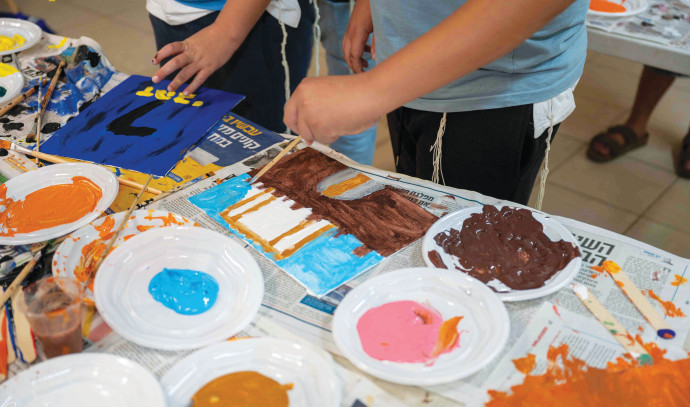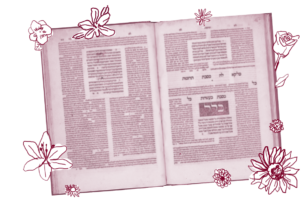What are the thoughts, feelings, and emotions that go through a five-year-old boy who is not living in the line of fire but still understands what is happening around the country?
Artist Ophra Shoshtari understands those tangled feelings and was asked to run an art activity for the children of Einav, a town in northern Samaria near Netanya, that would allow the youngsters to express themselves visually.
“Most of the children drew houses, flowers, and trees. I asked each child to tell me their name and what they drew, and I wrote out a label for them, just like in the galleries of a museum. They even painted a gold-colored frame for each picture,” says Shoshtari.
A five-year-old boy, Maor, showed her his painting.
Shoshtari: “What did you draw?”
Maor: “It’s a sun and sky and a safe room.”
Shoshtari: “Who is that inside the safe room?”
Maor: “It’s Dad.”
Shoshtari: “And the second person there is your mother?”
Maor: “No, the boy is just a child, and he is hugging his father.”
The therapeutic powers of art
Though not an art therapist, Shoshtari understands that art can be very therapeutic. In addition to creating her own artworks, she curates exhibitions and runs a nonprofit organization that publicizes the works of artists from Judea and Samaria through art exhibitions, activities, and more.
As a result of the Einav art project, the youth of the town, aged four to 15, learned about the journey of a painting from an artist’s studio to a museum wall. They were then given a small canvas and had to think of what they wanted to paint.
Some were afraid, and some drawings did not turn out the way they wanted. For others, the assignment came more naturally; and for others, it didn’t happen at all. Nine girls decided to work together and connect their canvases into a collage, resulting in a powerful creation.
Afterward, the children were asked to describe what they drew. For some, it was not easy to express themselves and reveal their innermost feelings to the world. But there was also a fun-filled atmosphere, with laughs, smiles, love, and encouragement.
“This was a place to breathe, to heal the soul,” Shoshtari says. “We are still here. We breathe. We are a people of souls. We will win.”
THE IDEA for the children’s art project was the brainchild of the Einav town council’s educational board. School wasn’t in session, and this was a way to help fill the gap. Shoshtari wrote lesson plans and gathered the necessary materials, all while mothering her own four young children.
Those participating gained insights into the world of art and how difficult it is for art to finally appear in the public sphere. Clearly, for the children this was a serious, therapy-like experience.
Roni, a teenager whose father’s family was evacuated from Gush Katif in 2005, says it was “really fun to draw the dream of returning to Gush Katif, to illustrate the unity of the people of Israel.
“We received a very painful blow, and only with unity will we win,” she says.
The message of love and unity for all kinds of Jews pervaded the artworks. “I am extremely proud of these kids and the teenagers as well,” Shoshtari says, beaming.
Ma’ayan, a teenage boy, came to a make-up session for some of the work he had missed, and stayed to watch Shoshtari and photographer Channah Lerman as they worked for hours setting up the exhibition in the town’s youth center.
For Ma’ayan, it was a real-time experience to learn about the process of creating an exhibition, of which his work was a part. He wrote a poem about his development of the entire project:
One blank and white canvas
That lies in front of me
With a brush, and paint that adds a shade of color
I drew a drawing from my heart
Ophra gave us the canvases without explanation or direction
“Just draw everything you see”
I enjoyed it
The opening of the exhibition was attended by a large contingent from the town. The display, which can be viewed by appointment, will remain in the youth center indefinitely.
A week after the opening, tragedy befell the small town of Einav when Elchanan Klein was shot and killed by a terrorist while serving in the army.
In light of this, several women asked Shoshtari to organize a similar project for the town’s women. She gave a lecture on color theory, followed by classes and an exhibition of their works.
MANY MAINTAIN that art can be a powerful therapeutic tool for those experiencing the devastating effects of war. Amid chaos and uncertainty, art can provide a safe space to express emotions, fears, and hopes. Engaging in art activities can help develop resilience and coping mechanisms.
These workshops also often facilitate the development of a supportive community, where participants can share their art and foster a sense of belonging and understanding.
Art in a war zone is not a panacea, but it can be a means of nurturing emotional well-being and assist in the healing process. Through art, it is possible for people to find solace, strength, and hope amid the turmoil that surrounds them. ■
The writer is a philanthropic consultant who advises individuals and foundations where to donate their tzedakah funds wisely, efficiently, and effectively. He can be reached at [email protected]; www.draimanconsulting.com.




